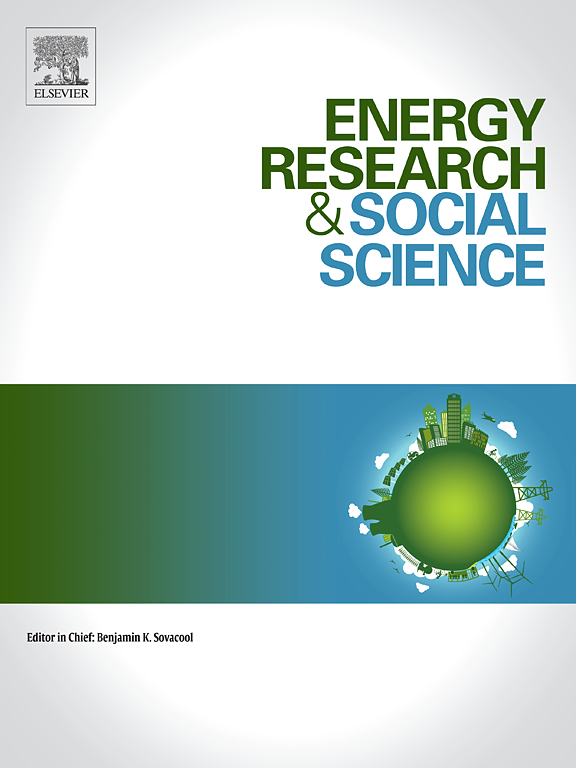通过全球参与式技术预测练习,实现集体气候地球工程的未来
IF 7.4
2区 经济学
Q1 ENVIRONMENTAL STUDIES
引用次数: 0
摘要
与其他重大挑战一样,气候变化提出了如何确保公众充分参与制定必要干预措施的基本问题。技术预见可能为实现这一目标提供了一种手段。本研究展示了一项技术预测练习的结果,该练习探索了涉及碳去除和太阳能地球工程等气候干预措施的潜在气候未来。我们采用了一种创新的方法,将科学技术预见与参与式研究相结合,即“参与式技术预见”。我们的实证分析集中在新兴的气候地球工程技术上,包括直接空气捕获、碳捕获和储存的生物能源、平流层气溶胶注入和海洋云增亮。在方法上,我们开发了一个原始的综合数据集,该数据集来自22个国家的44个城市和农村公共焦点小组。我们的分析确定了五种不同但共同的气候地球工程未来:全球绿化带、城市碳花园、土壤科学革命、与平流层气溶胶注入相关的作物歉收和癌症,以及星际遮阳板。该研究考察了这些未来的机遇和威胁,以及所涉及的行动者。该研究的结论是,参与式技术预见为公众充分参与制定应对重大挑战的政策提供了一个特别有价值的工具。本文章由计算机程序翻译,如有差异,请以英文原文为准。
Collective climate geoengineering futures through a global participatory technology foresight exercise
Climate change, like other Grand Challenges, raises fundamental issues with how to ensure the public feel fully involved in developing necessary interventions. Technology foresight potentially offers a means to achieve this. This study presents the results of a technology foresight exercise that explores potential climate futures involving climate interventions such as carbon removal and solar geoengineering. We utilize an innovative approach that integrates elements of science and technology foresight with participatory research—instead, “participatory technology foresight”. Our empirical analysis concentrates on emerging climate geoengineering technologies, including direct air capture, bioenergy with carbon capture and storage, stratospheric aerosol injection, and marine cloud brightening. Methodologically, we develop an original and comprehensive dataset drawn from 44 public focus groups in both urban and rural settings across 22 countries. Our analysis identified five distinct yet collective climate geoengineering futures: A Global Green Belt, Urban Carbon Gardens, A Scientific Revolution in Soils, Crop Failure and Cancer associated with stratospheric aerosol injection, and An Interplanetary Sunshield. The study examines these futures regarding opportunities and threats as well as the actors involved. The study concludes that participatory technology foresight provides a particularly valuable tool for fully engaging the public in developing policies to confront Grand Challenges.
求助全文
通过发布文献求助,成功后即可免费获取论文全文。
去求助
来源期刊

Energy Research & Social Science
ENVIRONMENTAL STUDIES-
CiteScore
14.00
自引率
16.40%
发文量
441
审稿时长
55 days
期刊介绍:
Energy Research & Social Science (ERSS) is a peer-reviewed international journal that publishes original research and review articles examining the relationship between energy systems and society. ERSS covers a range of topics revolving around the intersection of energy technologies, fuels, and resources on one side and social processes and influences - including communities of energy users, people affected by energy production, social institutions, customs, traditions, behaviors, and policies - on the other. Put another way, ERSS investigates the social system surrounding energy technology and hardware. ERSS is relevant for energy practitioners, researchers interested in the social aspects of energy production or use, and policymakers.
Energy Research & Social Science (ERSS) provides an interdisciplinary forum to discuss how social and technical issues related to energy production and consumption interact. Energy production, distribution, and consumption all have both technical and human components, and the latter involves the human causes and consequences of energy-related activities and processes as well as social structures that shape how people interact with energy systems. Energy analysis, therefore, needs to look beyond the dimensions of technology and economics to include these social and human elements.
 求助内容:
求助内容: 应助结果提醒方式:
应助结果提醒方式:


